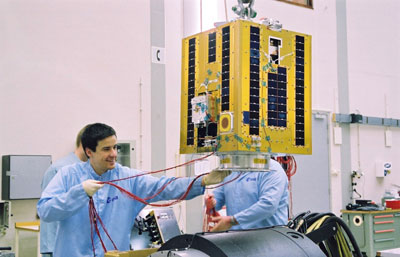Student satellites: encouraging trend or a sign of panic?by Taylor Dinerman
|
| CubeSats are not just for college students any more. At the Thomas Jefferson High School for Science and Technology in Virginia they are build the TJCubeSat, sponsored by Orbital Sciences Corporation. |
In 2002, the Commission on the Future of the United States Aerospace Industry, also known as the Walker Commission, wrote, “It is clear, therefore, that in the 21st century, the U.S. must continue to have a highly skilled, stable, secure, and growing aerospace workforce, and a citizenry that is well prepared in mathematics and science.” The commission’s surveys showed that “Engineering students also gave the aerospace industry low ratings for its physical work facilities, exciting and meaningful tasks, opportunities for professional development and growth, and supporting and encouraging management.” That’s not a good sign, and there are few indications that things have gotten better since the report was written.
What seems to be happening is that, as usual, when faced with a failure of government, people and private businesses are finding ways to get around the problem. First and foremost they are teaching themselves: home schooling is bigger than ever, and clubs and informal self-education groups are taking the place of old-style establishments, as are on-line universities. In the space industry amateur rocket clubs are growing and now student satellite projects are becoming ever more common.
In the US the National Space Grant Student Satellite Program has been successful in getting instructors and students from schools such as Universities of Arizona, Kansas, Hawaii, Cornell, Montana State and Cal Poly to build small CubeSats. These spacecraft are all a standard size of 10 cm x 10cm x 10cm to make them easy to package and launch as secondary or tertiary payloads. Some of these were lost in 2006 when the Russian Dnepr they were to ride on, crashed. In spite of this setback the program has continued.
CubeSats are not just for college students any more. At the Thomas Jefferson High School for Science and Technology in Virginia they are build the TJCubeSat, sponsored by Orbital Sciences Corporation. As with most student satellites, it will carry a simple communications payload. The important thing is that it is being built by a secondary school, which shows that this class of spacecraft can be used to prepare kids who are in the 14-to-18-year-old age bracket.
Studies show that while younger children are fascinated by spaceflight, when they become high school freshmen they tend to lose interest in the subject. If these projects become widespread this may have an substantial impact on the “enthusiasm gap” . Student competitions and something like a new high school space X Prize might be a logical next step, with the winning team demonstrating reliability, durability, and instrument performance.
Outside the US, student satellite programs have proliferated everywhere from Japan to Colombia to Denmark and Holland. A larger ESA-sponsored satellite was launched in October 2005. The Student Space Exploration and Technology Initiative (SSETI) Express satellite weighed 52 kilograms and was the product of a successful Internet-based pan-European cooperative effort. The educational value of these projects is obviously something that is now recognized worldwide.
In the US NASA wants to take the whole concept one step further and has released a Request for Information for an effort that will lead to the launch of the American Student Moon Orbiter (ASMO). Pete Worden, head of the Ames Research Center, said, “NASA is laying the foundation for a multi-generation exploration program that eventually will see humans settle our solar system. To sustain this vision we need the next crop of scientists and engineers to engage their minds and get hands on experience.” It’s the hands-on experience that counts.
There are few enough chances for fully-trained engineers to design and build operational spacecraft. The situation now is not as bad as it was fifteen or twenty years ago, before Dan Goldin began the controversial “Faster Better Cheaper” concept that, in spite of the failures, at least moved the space agency away from only launching giant, once-a-decade planetary missions. Now space engineers can expect to build and launch more than one or two spacecraft in their entire careers. Projects like ASMO are an indication that NASA is starting to rethink and refocus its role in US education.
| Without such programs the industry will find itself contracting and outsourcing more and more work, not due to any lack of funds, but due solely to a lack of a qualified American workforce. |
No one in the space industry should have any illusions: recruiting and training the scientists and engineers for the next set of large-scale space exploration missions is going to be hard. The industry needs to use every good idea and take advantage of every opening it can find. Students who might reject the idea of astronautics as being too “nerdy” might find that working on a real live satellite or space probe is a greater challenge than the alternatives.
Some have proposed that a fleet of student satellites be sent into orbit around Mars. It is exactly this kind of ambitious project that can excite young people and give this generation a smaller version of the boost that science and technology got from the Sputnik shock of 1958. Without such programs the industry will find itself contracting and outsourcing more and more work, not due to any lack of funds, but due solely to a lack of a qualified American workforce.
